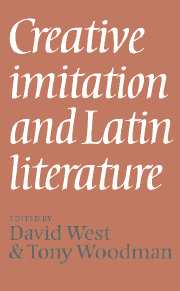Book contents
- Frontmatter
- Contents
- CONTRIBUTORS
- Prologue
- 1 DE IMITATIONE
- 2 PLAVTVS VORTIT BARB ARE: Plautus, Bacchides 526–61 and Menander, Dis exapaton 102–12
- 3 FROM POLYPHEMUS TO CORYDON: Virgil, Eclogue 2 and the Idylls of Theocritus
- 4 TWO PLAGUES: Virgil, Georgics 3.478–566 and Lucretius 6.1090–1286
- 5 HORATIAN IMITATIO AND ODES 2.5
- 6 IVDICIVM TRANSFERENDI: Virgil, Aeneid 2.469–505 and its antecedents
- 7 SELF-IMITATION WITHIN A GENERIC FRAMEWORK: Ovid, Amores 2.9 and 3.11 and the renuntiatio amoris
- 8 SELF-IMITATION AND THE SUBSTANCE OF HISTORY: Tacitus, Annals 1.61–5 and Histories 2.70, 5.14–15
- 9 LENTE CVRRITE, NOCTIS EQVI: Chaucer, Troilus and Criseyde 3.1422–70, Donne, The Sun Rising and Ovid, Amores 1.13
- 10 PYRAMUS AND THISBE IN SHAKESPEARE AND OVID: A Midsummer Night's Dream and Metamorphoses 4.1–166
- 11 EPILOGUE
- Notes
- Abbreviations and bibliography
- Select indexes
3 - FROM POLYPHEMUS TO CORYDON: Virgil, Eclogue 2 and the Idylls of Theocritus
Published online by Cambridge University Press: 12 March 2010
- Frontmatter
- Contents
- CONTRIBUTORS
- Prologue
- 1 DE IMITATIONE
- 2 PLAVTVS VORTIT BARB ARE: Plautus, Bacchides 526–61 and Menander, Dis exapaton 102–12
- 3 FROM POLYPHEMUS TO CORYDON: Virgil, Eclogue 2 and the Idylls of Theocritus
- 4 TWO PLAGUES: Virgil, Georgics 3.478–566 and Lucretius 6.1090–1286
- 5 HORATIAN IMITATIO AND ODES 2.5
- 6 IVDICIVM TRANSFERENDI: Virgil, Aeneid 2.469–505 and its antecedents
- 7 SELF-IMITATION WITHIN A GENERIC FRAMEWORK: Ovid, Amores 2.9 and 3.11 and the renuntiatio amoris
- 8 SELF-IMITATION AND THE SUBSTANCE OF HISTORY: Tacitus, Annals 1.61–5 and Histories 2.70, 5.14–15
- 9 LENTE CVRRITE, NOCTIS EQVI: Chaucer, Troilus and Criseyde 3.1422–70, Donne, The Sun Rising and Ovid, Amores 1.13
- 10 PYRAMUS AND THISBE IN SHAKESPEARE AND OVID: A Midsummer Night's Dream and Metamorphoses 4.1–166
- 11 EPILOGUE
- Notes
- Abbreviations and bibliography
- Select indexes
Summary
THE POEM AND ITS PATRON: ‘POLLIO AMAT NOSTRAM QVAMVIS EST RVSTICA MVSAM’
The second Eclogue is an example of imitatio in Latin poetry at its most skilful and its most successful. But before turning to consider the text in detail, it will be helpful to recall the cultural context in which it was composed and designed to be read. The Eclogues were written in the turbulent years which followed the assassination of Julius Caesar (42–39 B.C.). They were commissioned by Virgil's patron, C. Asinius Pollio, a former friend and supporter of the dictator and currently the friend and supporter of M. Antonius and the triumvirs. At this time he was reaching the summit of his meteoric career: a consul designate and in command of the key province of Gallia Cisalpina in 41; consul in 40; proconsul and destined to become a uir triumphalis in 39. It is perhaps not immediately obvious why such a man should be interested in promoting poems written in imitation of the Hellenistic poet Theocritus. Personal taste doubtless played its part. Pollio was himself a literary man whose tragedies had won some fame. He was a friend of the leading ‘Neoteric’ C. Helvius Cinna and the patron of the inventor of Latin love elegy, the cantor Euphorionis, C. Cornelius Gallus. In his youth he had known Catullus who had paid him a gracious compliment (12.8f.): est enim leporum | differtus puer ac facetiarum. It is noteworthy that the poems he commissioned were later complimented by Horace in very similar terms (Satires 1.10.44f.): molle atque facetum | Vergilio adnuerunt gaudentes rure Camenae.
- Type
- Chapter
- Information
- Creative Imitation and Latin Literature , pp. 35 - 70Publisher: Cambridge University PressPrint publication year: 1979
- 53
- Cited by



